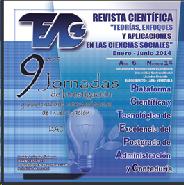Audit program adressed to human resource assessment system of health and safety in food marketing companies (case MERCABAR)
Keywords:
human resource audit, hygiene and occupational safety, risk, workersAbstract
This paper is intended to propose a human resource audit program for hygiene and safety system work in food marketing companies, taking as a case study the Wholesale Food Market in Barquisimeto, MERCABAR CA. This work was framed in the context of descriptive study design field in non-experimental trans. Direct observation, semi-structured interviews, and questionnaires administered to a selected sample of all employees working in the company were used. To carry out the analysis results, statistical means and an analysis matrix were used that allowed interpretation of data obtained. This study is highly relevant, because it conceived information about the current situation of occupational health and safety of one of the food market centers in the country such as MERCABAR CA, which will serve to correct and improve possible failures an organization in this area could have. It also contributes to take actions and guidelines for the company to avoid risk of incidents at work, accidents at work and occupational diseases workforce might go through, and possible sanctions for breaching parameters established in the current legislation in this area. The data allowed an audit program proposal, which will serve as a tool for public accounting professional to assess the occupational health and safety in this type of organization which are important for the nation food supply.
Downloads
References
Chiavenato, Idalberto (2000). Administración De Recursos Humanos 5ta. Edición. Editorial Mc Graw Hill. México.
Chiavenato, Idalberto (2006). Introducción A La Teoría General De La Administración 7ma. Edición, Editorial Mc Graw Hill. México.
Constitución De La República Bolivariana De Venezuela. (1999). Gaceta Oficial De La República Bolivariana De Venezuela Nº 5.453. Marzo 24, 2000. Venezuela.
Constitución Nacional De La República Bolivariana De Venezuela.
Decreto con Rango, Valor Y Fuerza De Ley Orgánica Del Trabajo, Los Trabajadores Y Las Trabajadoras, Lottt. (Decreto Presidencial Nº 8.938 Del 30 De Abril De 2012.)
Fundación Mapfre (1991). Manual De Higiene Industrial. Editorial Mapfre. Madrid. http://www.medicinalaboraldevenezuela.com.ve (Consulta: Diciembre, 15, 2012)
Instituto Nacional de Prevención, Salud y Seguridad Laborales. http://www.inpsasel.gob.ve/. (Consulta: Octubre 31, 2011) Instituto venezolano de los seguros sociales. http://www.ivss.gov.ve (Consulta: Octubre 31,2011)
Kayser, Beatriz (2007). Higiene Y Seguridad Industrial. Atlantic Internacional University. Buenos Aires.
Ley Orgánica De Prevención, Condiciones Y Medio Ambiente De Trabajo, Lopcymat. (G.O. N° 38236 Del 26 De Julio De 2005)
Medinacelis Alvaro (1995). Del Manteco A Mercabar. Fundación Polar. Caracas.
Ministerio Del Poder Popular Para El Trabajo. www.minpptrass.gob.ve. (Consulta: Octubre 31, 2011)
Molina J. (2004). Higiene Y Seguridad Industrial En Venezuela. http://juanmolina.blog.com.es/ (Consulta: Noviembre 11, 2011)
Morguez A (2007). ¿Cómo Seleccionar El Tamaño De Una Muestra Para Una Investigación Educacional http://www.monografias.com/trabajos42/seleccion muestra/seleccion-muestra2.shtml. (Consulta: Febrero 18, 2012)
Organización Mundial De La Salud. http://www.who.int/ es/. (Consulta: Noviembre 12, 2011)
Ramírez, César. (2000). Seguridad Industrial: Un Enfoque Integral. Editorial Limusa. México.
Reglamento Parcial De La Ley Orgánica De Prevención, Condiciones Y Medio Ambiente Del Trabajo, Rlopcymat. (G.O. N° 38596 Del 3 De Enero De 2007).
Reyes Ponce, Agustín (2005). Administracion De Personal, Relaciones Humanas 1era. Parte. Editorial Limusa. México.
Sabino A (2000). Metodología De La Investigación. Editorial El Cid. Caracas.
Van Der Harr, Rudolf Y Otros (2001). La Higiene Ocupacional En América Latina. Organización Mundial Para La Salud (Oms). Washington.
Velásquez R. Cómo Evaluar Un Sistema De Gestión De La Seguridad E Higiene Ocupacional. http://www.gestiopolis.com/canales/derrhh/articulos/25/ceusgho.htm. (Consulta: Febrero 01, 2012)
Published
How to Cite
Issue
Section
Derechos del/de autor/es a partir del año de publicación
Esta obra está bajo la licencia:
Creative Commons Reconocimiento-NoComercial-CompartirIgual 4.0 Internacional (CC BY-NC-SA 4.0)
Las opiniones expresadas por los autores no necesariamente reflejan la postura del editor de la publicación ni de la UCLA. Se autoriza la reproducción total o parcial de los textos aquí publicados, siempre y cuando se cite la fuente completa y la dirección electrónica de esta revista. Los autores(as) tienen el derecho de utilizar sus artículos para cualquier propósito siempre y cuando se realice sin fines de lucro. Los autores(as) pueden publicar en internet o cualquier otro medio la versión final aprobada de su trabajo, luego que esta ha sido publicada en esta revista.



